2003 PONTIAC GRAND PRIX parking brake
[x] Cancel search: parking brakePage 253 of 378
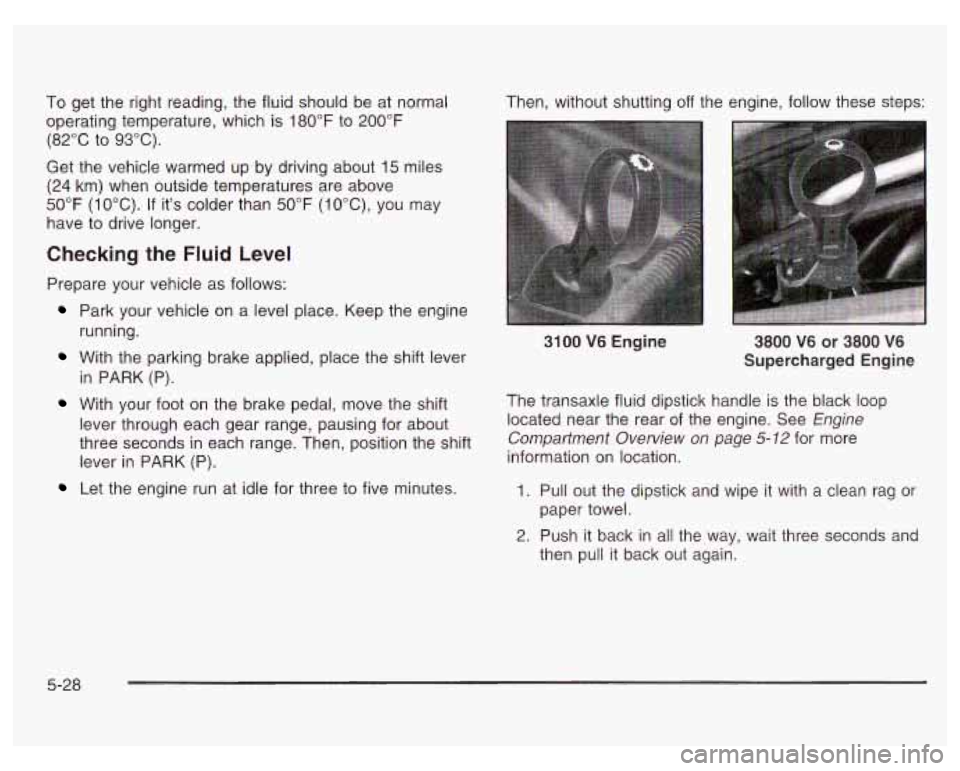
To get the right reading, the fluid should be at normal
operating temperature, which is 180°F to 200°F
(82°C to 93°C).
Get the vehicle warmed up by driving about
15 miles
(24 km) when outside temperatures are above
50°F (1 0°C). If it's colder than 50°F (IO'C), you may
have to drive longer.
Checking the Fluid Level
Prepare your vehicle as follows:
Park your vehicle on a level place. Keep the engine
running.
With the parking brake applied, place the shift lever in
PARK (P).
With your foot on the brake pedal, move the shift
lever through each gear range, pausing for about
three seconds in each range. Then, position the shift
lever in PARK (P).
Let the engine run at idle for three to five minutes. Then,
without shutting
off the engine, follow these steps:
3100 V6 Engine 3800 V6 or 3800 V6
Supercharged Engine
The transaxle fluid dipstick handle is the black loop
located near the rear of the engine. See Engine
Comparfment Overview
on page 5-12 for more
information on location.
1. Pull out the dipstick and wipe it with a clean rag or
2. Push it back in all the way, wait three seconds and
paper
towel.
then pull it back out again.
5-28
Page 279 of 378

Notice: If the other system isn’t a 12-volt system
with a negative ground, both vehicles can be
damaged.
1. Check the other vehicle. It must have a 12-volt
battery with a negative ground system.
2. Get the vehicles close enough so the jumper cables
can reach, but be sure the vehicles aren’t touching
each other. If they are, it could cause a ground
connection you don’t want. You wouldn’t be able to
start your vehicle, and the bad grounding could
damage the electrical systems.
To avoid the possibility of the vehicles rolling, set
the parking brake firmly on both vehicles involved in
the jump start procedure. Put an automatic
transaxle in PARK
(P) or a manual transaxle in
NEUTRAL before setting the parking brake.
Notice: If you leave your radio on, it could be badly
damaged. The repairs wouldn’t be covered by
your warranty.
3. Turn off the ignition on both vehicles. Unplug
unnecessary accessories plugged into the cigarette
lighter or in the accessory power outlet. Turn
off
the radio and all lamps that aren’t needed. This will
avoid sparks and help save both batteries. And it
could save your radio!
4. Open the hoods and locate the batteries. Find the
positive
(+) and negative (-) terminal locations on
each vehicle. You will not need to access your
battery for jump starting. Your vehicle has
a remote
positive
(+) jump starting terminal for that purpose.
The terminal is located in the engine compartment
on the passenger’s side of the vehicle, near
the diagonal cross brace. See Engine Compartment
Ovewiew
on page 5-72 for more information on
location.
5-54
Page 301 of 378
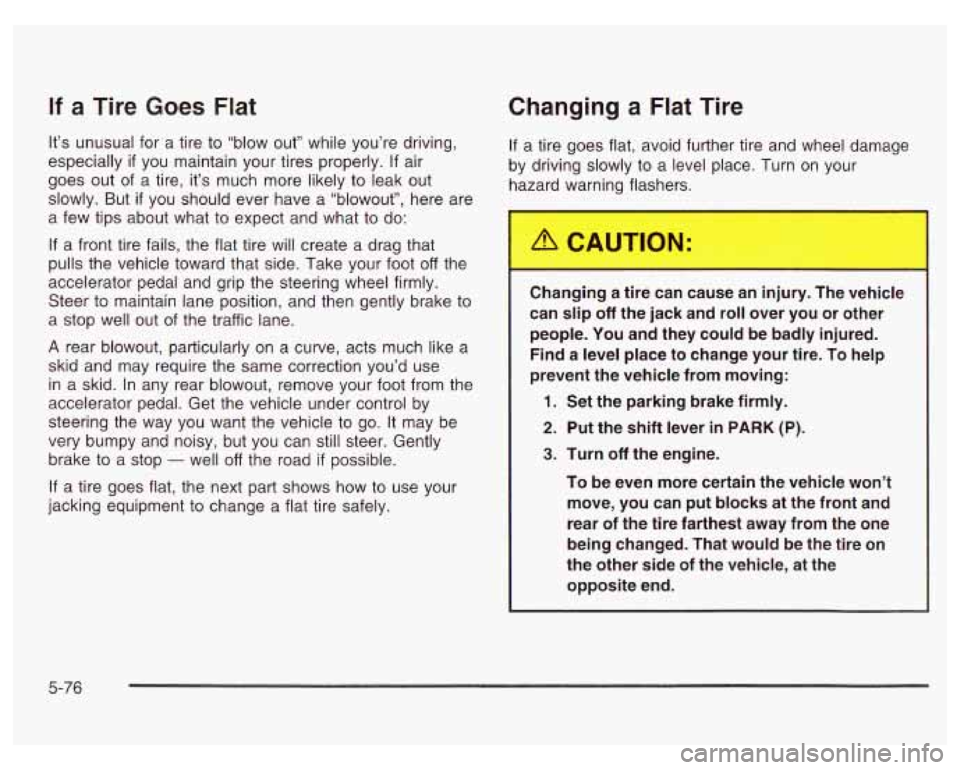
If a Tire Goes Flat
It’s unusual for a tire to “blow out” while you’re driving,
especially
if you maintain your tires properly. If air
goes out of a tire, it’s much more likely
to leak out
slowly. But
if you should ever have a “blowout”, here are
a few tips about what to expect and what to do:
If a front tire fails, the flat tire will create a drag that
pulls the vehicle toward that side. Take your foot
off the
accelerator pedal and grip the steering wheel firmly.
Steer to maintain lane position, and then gently brake to
a stop well out of the traffic lane.
A rear blowout, particularly on a curve, acts much like a
skid and may require the same correction you’d use
in a skid. In any rear blowout, remove your foot from the
accelerator pedal. Get the vehicle under control by
steering the way you want the vehicle to go.
It may be
very bumpy and noisy, but you can still steer. Gently
brake to a stop
- well off the road if possible.
If a tire goes flat, the next part shows how to use your
jacking equipment to change a flat tire safely.
Changing a Flat Tire
If a tire goes flat, avoid further tire and wheel damage
by driving slowly to a level place. Turn
on your
hazard warning flashers.
I
Chant_ g a tire can cause an injury. The v icle
can slip
off the jack and roll over you or other
people.
You and they could be badly injured.
Find a level place to change your tire. To help
prevent the vehicle from moving:
1. Set the parking brake firmly.
2. Put the shift lever in PARK (P).
3. Turn off the engine.
To be even more certain the vehicle won’t move, you can put blocks at the front and
rear of the tire farthest away from
the one
being changed. That would be the tire on
the other side of the vehicle, at the
opposite end.
5-76
Page 340 of 378
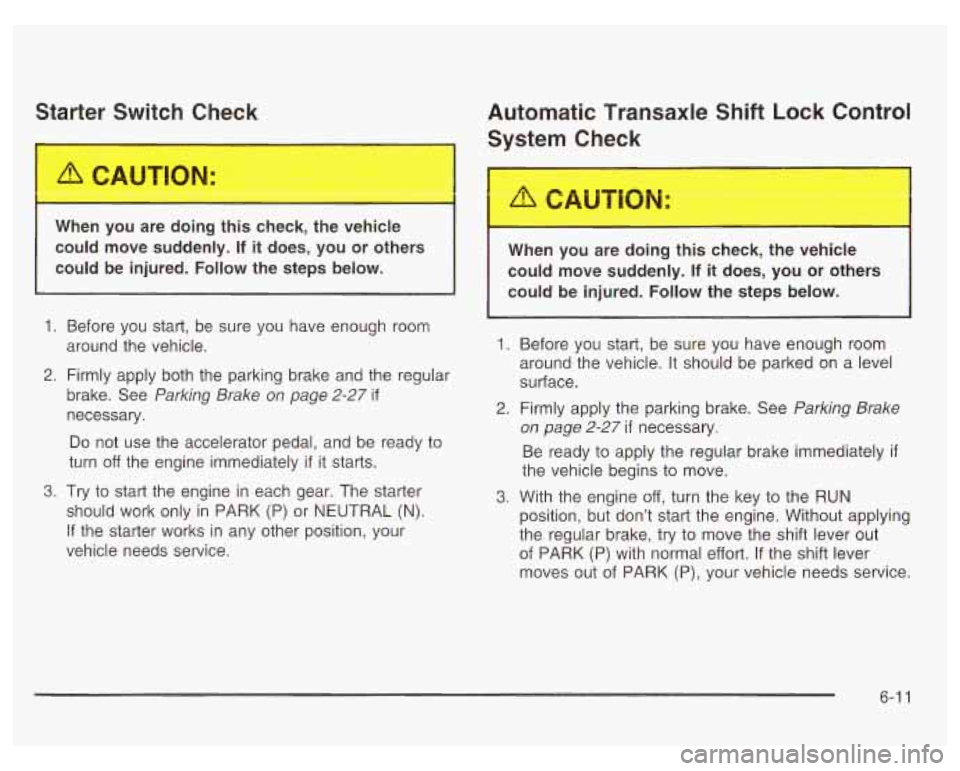
Starter Switch Check Automatic Transaxle Shift Lock Control
System Check
1. Before you start, be sure you have enough room
around the vehicle.
2. Firmly apply both the parking brake and the regular
brake. See Parking Brake on page 2-27
if
necessary.
Do not use the accelerator pedal, and be ready to
turn off the engine immediately
if it starts.
3. Try to start the engine in each gear. The starter
should work only in PARK
(P) or NEUTRAL (N).
If the starter works
in any other position, your
vehicle needs service.
When you are doi - lis check, the vehicle
could move suddenly.
If it does, you or others When you are doing this ieck, the vehicle
could be injured. Follow the steps below. could move suddenly.
If it does, you or others
could be injured. Follow the steps below.
1. Before you start, be sure you have enough room
around the vehicle.
It should be parked on a level
surface.
2. Firmly apply the parking brake. See Parking Brake
on page 2-27
if necessary.
Be ready to apply the regular brake immediately
if
the vehicle begins to move.
3. With the engine off, turn the key to the RUN
position, butdon’t start the engine. Without applying
the regular brake, try to move the shift lever out
of PARK
(P) with normal effort. If the shift lever
moves out of PARK (P), your vehicle needs service.
6-1 1
Page 341 of 378
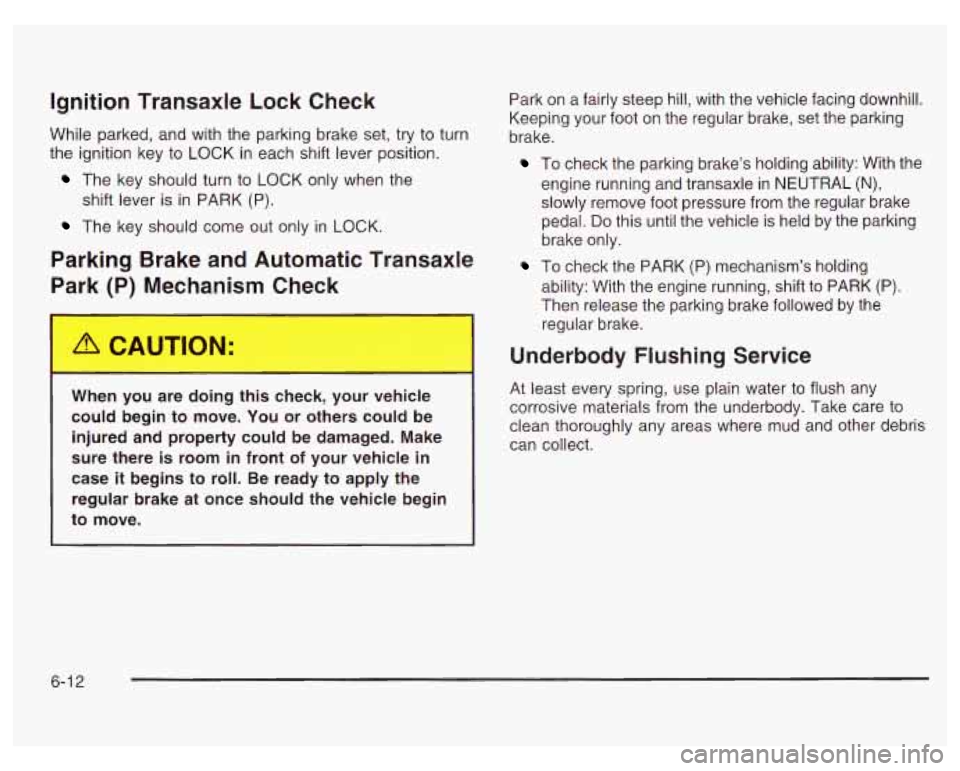
Ignition Transaxle Lock Check
While parked, and with the parking brake set, try to turn
the ignition key
to LOCK in each shift lever position.
The key should turn to LOCK only when the
The key should come out only in LOCK.
shift lever
is in PARK (P).
Parking Brake and Automatic Transaxle
Park Mechanism
C leck
---
Y
When you are doing this check our vehicle
could begin to move. You or others could be
injured and property could be damaged. Make
sure there is room in front
of your vehicle in
case it begins
to roll. Be ready to apply the
regular brake
at once should the vehicle begin
to move.
Park on a fairly steep hill, with the vehicle facing downhill.
Keeping your foot on the regular brake, set the parking
brake.
To check the parking brake’s holding ability: With the
engine running and transaxle in NEUTRAL (N),
slowly remove foot pressure from the regular brake
pedal.
Do this until the vehicle is held by the parking
brake only.
ability: With the engine running, shift
to PARK (P).
Then release the parking brake followed by the
regular brake.
To check the PARK (P) mechanism’s holding
I Underbody Flushing Service
At least every spring, use plain water to flush any
corrosive materials from the underbody. Take care to
clean thoroughly any areas where mud and other debris
can collect.
6-1 2
Page 343 of 378
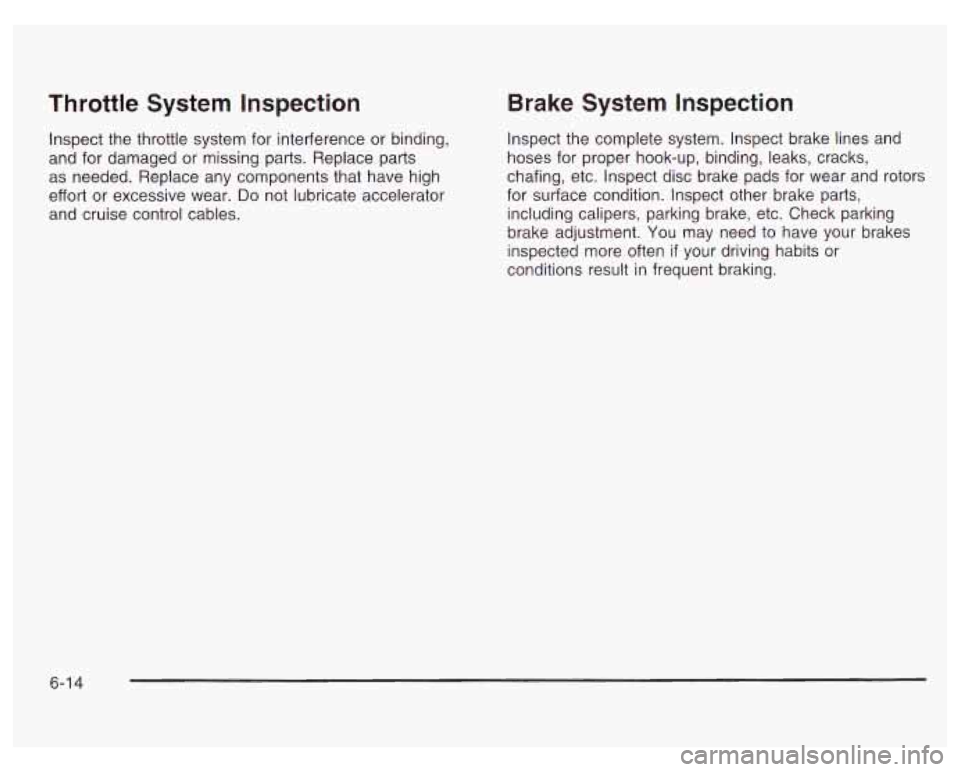
Throttle System Inspection
Inspect the throttle system for interference or binding,
and for damaged or missing parts. Replace parts
as needed. Replace any components that have high
effort or excessive wear.
Do not lubricate accelerator
and cruise control cables.
Brake System Inspection
Inspect the complete system. Inspect brake lines and
hoses for proper hook-up, binding, leaks, cracks,
chafing, etc. Inspect disc brake pads for wear and rotors
for surface condition. Inspect other brake parts,
including calipers, parking brake, etc. Check parking
brake adjustment.
You may need to have your brakes
inspected more often
if your driving habits or
conditions result in frequent braking.
6-1 4
Page 361 of 378
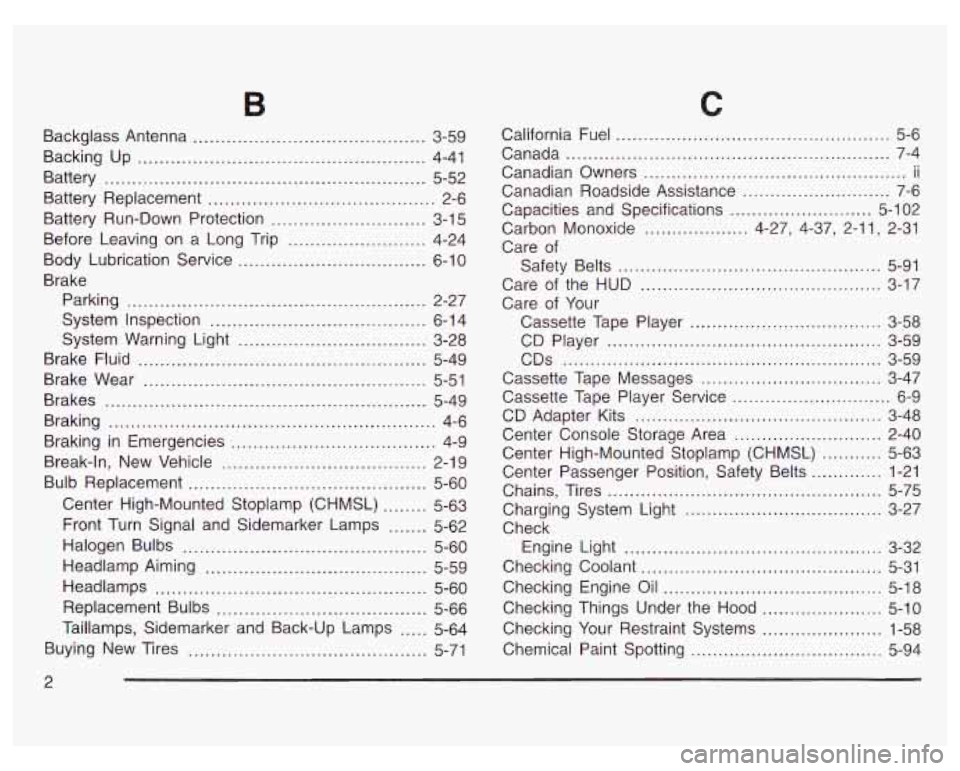
Backglass Antenna .......................................... 3-59
Backing Up .................................................... 4-41
Battery .......................................................... 5-52
Battery Replacement ......................................... 2-6
Battery Run-Down Protection ............................ 3-1 5
Before Leaving on a Long Trip ......................... 4-24
Body Lubrication Service .......................... 6-10
Brake
Parking
...................................................... 2-27
System Inspection ....................................... 6-1 4
System Warning Light .................................. 3-28
Brake Fluid .................................................... 5-49
Brake Wear ................................................... 5-51
Brakes .......................................................... 5-49
Braking ........................................................... 4-6
Break-In, New Vehicle ..................................... 2-19
Bulb Replacement ........................................... 5-60
Center High-Mounted Stoplamp (CHMSL) ........ 5-63
Front Turn Signal and Sidemarker Lamps ....... 5-62
Halogen Bulbs ............................................ 5-60
Headlamp Aiming ........................................ 5-59
Headlamps ................................................. 5-60
Replacement Bulbs ...................................... 5-66
Taillamps, Sidemarker and Back-up Lamps ..... 5-64
Buying New Tires ........................................... 5-71
Braking in Emergencies ..................................... 4-9
C
California Fuel .................................................. 5-6
Canada ........................................................... 7-4
Canadian Owners ................................................ ii
Canadian Roadside Assistance ........................... 7-6
Capacities and Specifications .......................... 5-1 02
Carbon Monoxide ................... 4-27, 4-37, 2-1 1, 2-31
Care of
Safety Belts ................................................ 5-91
Care of the HUD ............................................ 3-17
Care of Your
Cassette Tape Player
................................... 3-58
CD Player .................................................. 3-59
Cassette Tape Messages ................................. 3-47
Cassette Tape Player Service ............................. 6-9
Center Console Storage Area ........................... 2-40
Center High-Mounted Stoplamp (CHMSL) ........... 5-63
Center Passenger Position, Safety Belts ............. 1-21
Chains, Tires .................................................. 5-75
Check
Checking Coolant
............................................ 5-31
Checking Things Under the Hood ...................... 5-10
Checking Your Restraint Systems ...................... 1-58
CDS .......................................................... 3-59
CD Adapter Kits ............................................. 3-48
Charging System Light .................................... 3-27
Engine Light ............................................... 3-32
Checking Engine Oil ........................................ 5-18
Chemical Paint Spotting ................................... 5-94
2
Page 369 of 378
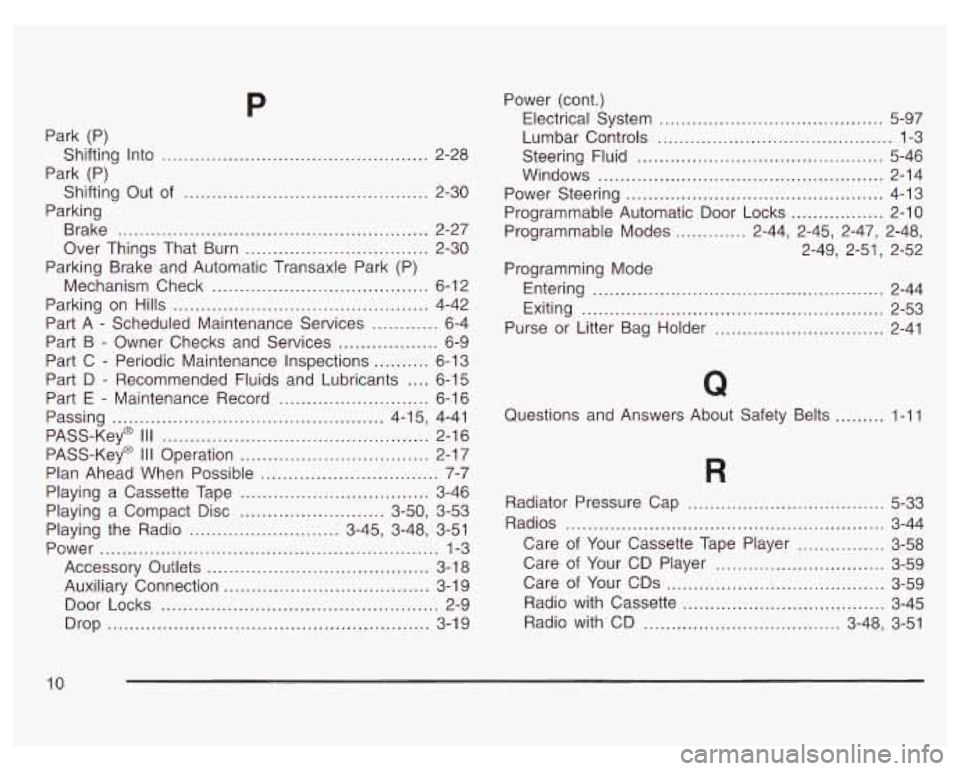
P
Park (P)
Park (P)
Parking Shifting Into
................................................ 2-28
Shifting Out of
............................................ 2-30
Brake
........................................................ 2-27
Over Things That Burn
................................. 2-30
Parking Brake and Automatic Transaxle Park (P)
Mechanism Check
....................................... 6-1 2
Parking
on Hills .............................................. 4-42
Part A
- Scheduled Maintenance Services ............ 6-4
Part
B - Owner Checks and Services .................. 6-9
Part
C - Periodic Maintenance Inspections .......... 6-13
Part D
- Recommended Fluids and Lubricants .... 6-1 5
Part E - Maintenance Record ........................... 6-16
Passing
................................................. 4-15, 4-41
PASS-Key@ Ill
................................................ 2-16
Plan Ahead When Possible
................................ 7-7
Playing a Cassette Tape
.................................. 3-46
Playing the Radio
........................... 3-45, 3-48, 3-51
Power
............................................................. 1-3
Accessory Outlets
........................................ 3-1 8
Auxiliary Connection
................................. 3-1 9
Door Locks
.............. ................. 2-9
Drop
....................... .... .... 3-19
PASS-Key@
Ill Operation .................................. 2-17
Playing a Compact Disc
.......................... 3-50, 3-53 Power (cont.)
Electrical System
......................................... 5-97
Lumbar Controls
........................................... 1-3
Steering Fluid
............................................. 5-46
Windows
.................................................... 2-14
Power Steering
............................................... 4-13
Programmable Automatic Door Locks
................. 2-10
Programmable Modes
............. 2-44, 2-45, 2-47, 2-48,
Programming Mode 2-49,
2-51, 2-52
Entering
..................................................... 2-44
Exiting
....................................................... 2-53
Purse or Litter Bag Holder
............................... 2-41
Questions and Answers About Safety Belts
......... 1-11
Radiator Pressure Cap
................................ 5-33
Radios
......................................... ......... 3-44
Care of Your Cassette Tape Player
................ 3-58
Care
of Your CD Player ............................... 3-59
Care of Your
CDs ........................................ 3-59
Radio with Cassette
..................................... 3-45
Radio with CD
.................................... 3-48, 3-51
10